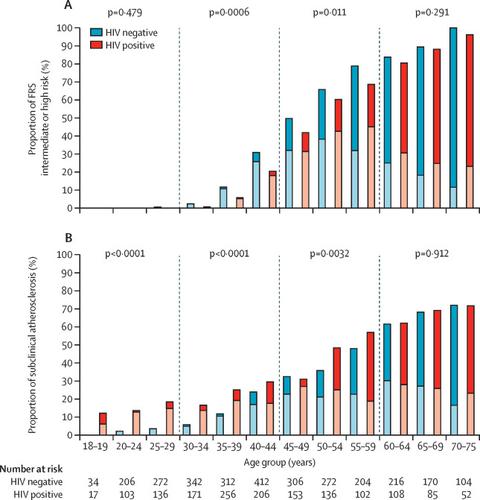The Lancet HIV ( IF 12.8 ) Pub Date : 2019-10-18 , DOI: 10.1016/s2352-3018(19)30263-2 Haijiang Lin 1 , Yingying Ding 2 , Chenxi Ning 3 , Xiaotong Qiao 3 , Xiaochen Chen 3 , Xiaoxiao Chen 1 , Weiwei Shen 1 , Xing Liu 2 , Yuling Hong 4 , Na He 2

|
Background
Inconclusive results have been reported in studies evaluating the association between HIV infection and subclinical atherosclerosis. Unsolved issues include whether the increased atherosclerosis burden observed in some studies is attributed to greater prevalence of traditional risk factors or HIV infection. Therefore, we evaluated the association of HIV infection with subclinical atherosclerosis as assessed by carotid artery intima-media thickness, while controlling for the effects of traditional risk factors as operationalised by the Framingham risk score (FRS).
Methods
We did a cross-sectional evaluation of data derived from the baseline assessment of the Comparative HIV and Aging Research in Taizhou (CHART) cohort, an ongoing longitudinal study being done in Zhejiang province, China. HIV-positive and HIV-negative individuals aged 18 years and older were recruited between Feb 1, and Dec 10, 2017, and were frequency-matched for age and sex in a 1:2 ratio. Subclinical atherosclerosis was defined as carotid artery intima-media thickness of 780 μm or higher. Logistic regression was used to assess the associations of HIV-positive serostatus and FRS with subclinical atherosclerosis.
Findings
480 of 1425 (36·1%, 95% CI 33·6–38·6) HIV-positive and 784 of 2850 (27·5%, 95% CI 25·9–29·2) HIV-negative individuals had subclinical atherosclerosis (p<0·0001), and these patterns remained significant (adjusted odds ratio [adjOR] 1·72, 95% CI 1·47–2·01) in the adjusted model. After stratifying by age, higher prevalence of subclinical atherosclerosis was observed in HIV-positive than in HIV-negative individuals across the age groups 18–29 years (41 [16·0%] of 256 vs 13 [2·5%] of 512, p<0·0001), 30–44 years (128 [24·0%] of 533 vs 153 [14·4%] of 1066, p<0·0001), and 45–59 years (182 [46·6%] of 391 vs 294 [37·6%] of 782, p=0·0032), but not 60–75 years (163 [66·5%] of 245 vs 324 [66·1%] of 490, p=0·912). Significant negative interaction between HIV-positive serostatus and age on subclinical atherosclerosis was observed (p<0·0001). ORs adjusted for age, sex, and FRS were 8·84 (95% CI 4·50–17·34) for the age group 18–29 years, 2·09 (1·59–2·74) for 30–44 years, 1·54 (1·19–1·98) for 45–59 years, and 1·04 (0·75–1·44) for 60–75 years. Among HIV-positive individuals, none of the HIV-specific variables were significantly associated with carotid artery intima-media thickness estimates except for being antiretroviral therapy naive.
Interpretation
HIV infection is associated with subclinical atherosclerosis, independent of classic risk factors. The association is stronger at younger ages, suggesting early onset of subclinical atherosclerosis among young adults. These findings highlight the need to modify HIV/AIDS treatment guidelines to incorporate cardiovascular evaluation in China.
Funding
China National Science and Technology Major Projects on Infectious Diseases, National Natural Science Foundation of China, and Shanghai Municipal Health and Family Planning Commission.











































 京公网安备 11010802027423号
京公网安备 11010802027423号